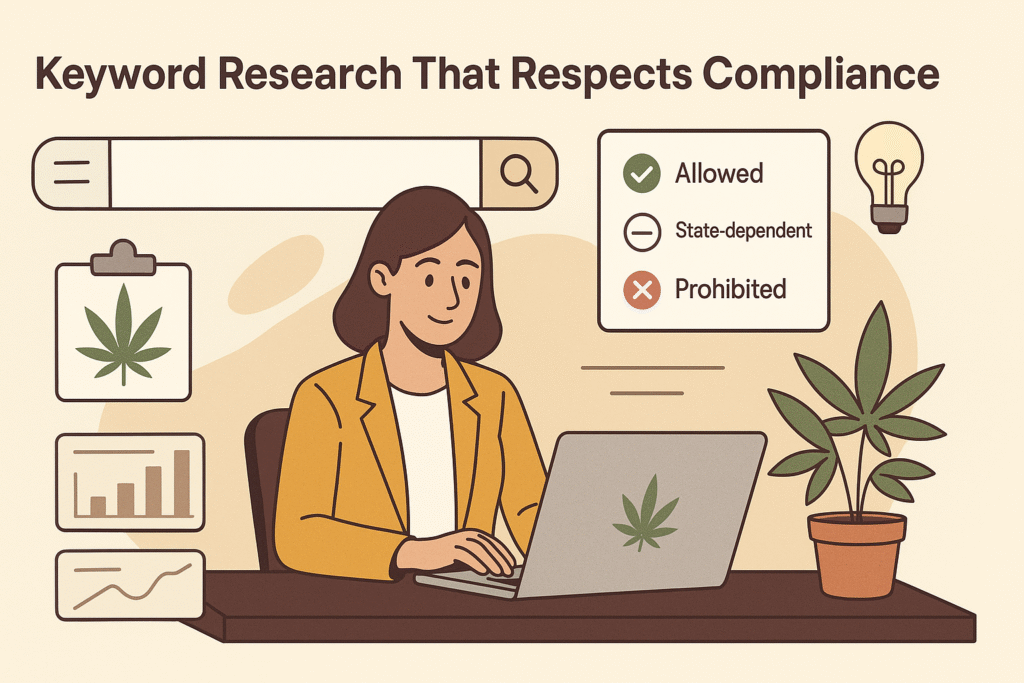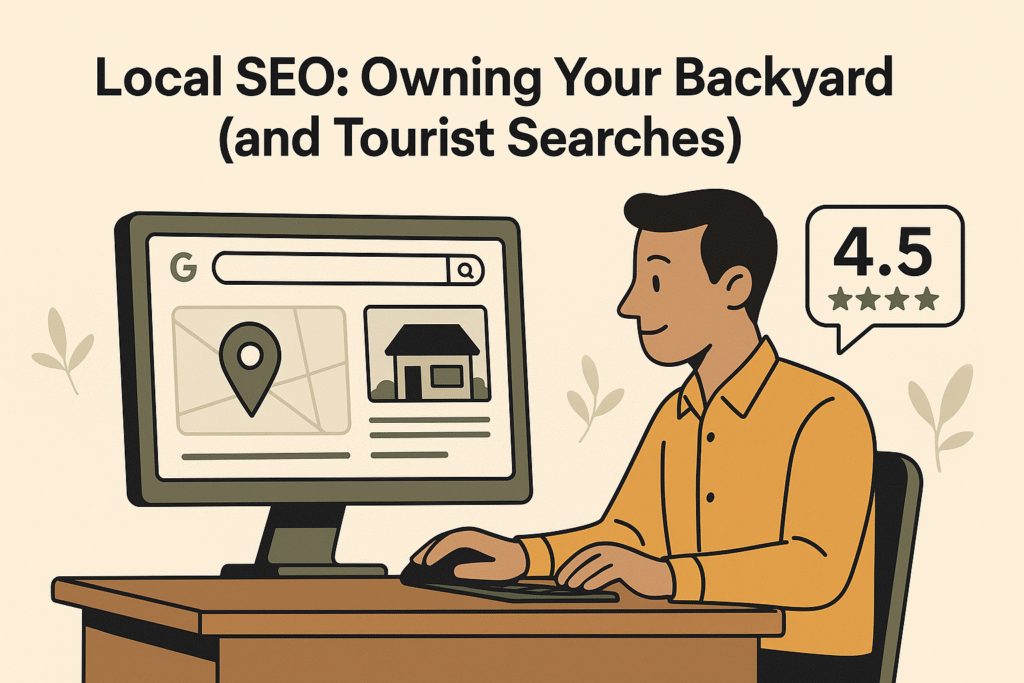Introduction
Search is the first stop for medical patients looking for recommended products, for tourists Googling “recreational dispensary near me,” and for investors scouting emerging brands. Yet because cannabis remains federally illegal in the U.S. (and tightly regulated in many other countries), traditional ad channels are riddled with red tape. That makes search‐engine optimization (SEO) the single most dependable growth lever for cannabis businesses in 2025.
This guide distills what GreenBoost has learned from auditing, optimizing, and promoting dozens of dispensary, ancillary‑service, and plant‑touching sites. You’ll walk away with actionable tactics that respect both Google’s E‑E‑A‑T signals and state/federal compliance rules.
1. The Cannabis SEO Landscape in 2025
Patchwork legality complicates intent. Cannabis SEO is important for ranking on different search results because users in prohibition states search informationally (“Is THC legal in Kansas?”) while users in adult‑use markets search transactionally (“buy live resin cartridges Phoenix”).
Ad restrictions push organic competition sky‑high. Brands competing for the same SERP real estate invest heavily in content, technical SEO, and PR to fill the paid‑ads vacuum.
E‑E‑A‑T matters extra. Because cannabis is a “Your Money or Your Life” (YMYL) topic, Google scrutinizes expertise and trust signals more aggressively. (E-E-A-T is a framework used by Google to assess the quality of content and websites. It stands for- Experience, Expertise, Authoritativeness, and Trustworthiness.)
Key takeaway: To win, you need granular keyword targeting, airtight compliance, and authority signals the algorithm can verify.
2. Keyword Research That Respects Compliance
Segment by intent and legality. Keyword research in this way is valuable because it allows you to create buckets for informational (“benefits of CBN”), commercial investigation (“best dispensary deals Denver”), and transactional (“order weed delivery Detroit”).
Mine every corner:
Google Search Console & GA4 for actual query data
SEMrush/ahrefs for volume and difficulty
Google Trends & “People Also Ask” for emerging questions
Industry‑specific databases like Weedmaps search insights
Long‑tail is life. “THC‑free CBD dog treats Alabama” may only get 100 searches/month but converts like crazy.
Mind restricted phrases. Avoid terms such as “ship THC nationwide” if your business can’t legally fulfill them.
Pro tip: Store each keyword’s compliance status (“Allowed,” “State‑dependent,” “Prohibited”) in your content calendar to save editorial headaches.

3. On‑Page SEO Fundamentals for Cannabis Sites
Craft Content Around Real Expertise For On Page SEO
Showcase licensed pharmacists, horticulturists, and budtenders as authors.
Cite peer‑reviewed studies (PubMed, JAMA) to back medical claims.
Optimize the Basics
| Element | Best Practice | |
|---|---|---|
| Title Tag | ≤ 60 chars, front‑load main keyword + brand (“Cannabis Web Design Agency-GreenBoost) | |
| Meta Description | Persuasive, ≤ 155 chars, include CTA & secondary keyword | |
| H1 | Clear, unique per page (“CBD SEO Services Explained”) | |
| URL Slug | lowercase, hyphenated, remove stop words (/cbd-seo-services) | |
| Schema | LocalBusiness, Product, FAQ, Review (ensure products with THC percentages list lab results) |
Compliance Callouts
Add age‑gate modals, THC disclaimers, and state license numbers in the footer to satisfy regulators and reassure Google’s quality raters.
4. Local SEO: Owning Your Backyard (and Tourist Searches)
Google Business Profile (GBP) One of the most important things for local SEO is your local business profile—Use the exact dispensary name on your license, upload geotagged photos weekly, and enable messaging.
NAP Consistency—Sync address and phone across Weedmaps, Yelp, Apple Maps, and cannabis‑friendly directories (Leafly, Dutchie).
Localized Content—Publish “Best Strains for Arizona Summer Heat” rather than generic “Best Sativa Strains.”
Review Strategy—Train budtenders to request reviews post‑purchase (no incentives that violate state rules). Respond to every review.

5. Technical SEO in a Heavily Scrutinized Niche
Core Web Vitals: Aim for a Largest Contentful Paint < 1.8 s. Use WP Rocket + Cloudflare APO.
Crawl Management: Block
/cart/and/checkout/from indexing, allow/menu/and/strains/.HTTPS & Security: SSL is table stakes; add automatic backups and firewall (iThemes Security) to protect customer data.
Accessibility: ARIA labels and alt text help ADA compliance and search ranking.
Speed hack: Lazy‑load high‑res product images, but not above‑the‑fold hero banners—Google frowns on delayed LCP elements.
6. Content Marketing That Passes the Sniff Test
| Format | Goal | Example |
| Educational Guides | Build authority | “Complete Terpene Chart & Effects (Downloadable PDF)” |
| How‑To Videos | Engage & keep dwell time | “DWC Setup in Under 10 Minutes” |
| Podcasts | Grow backlinks through guest experts | “Women Leading the Cannabis Supply Chain” |
| Interactive Tools | Earn embeds | “Cannabis Tax Rate Calculator by State” |
Mix evergreen (strain encyclopedias) with news‑jacking (DEA rescheduling updates). Promote via email and niche subreddits instead of ad‑blocked social posts.
7. Link‑Building Without Raising Red Flags
Digital PR: Pitch local newspapers on economic impact stories.
Industry Roundups: Contribute expert quotes to cannabis science blogs.
Scholarships & Grants: Offer a “GreenBoost Cannabis Research Scholarship” linked from .edu pages.
Event Sponsorships: Acquire links from expo sponsor pages (MJBizCon, NECANN).
Avoid PBNs and spammy “weed blog farms”—Google has a long memory.
8. Social & Influencer Synergy

Platform Policies Differ: Meta bans direct product ads; X (Twitter) allows state‑licensed ads with restrictions.
UGC Is Safer: Encourage user‑generated content tags like #MyFirstGrow rather than posting consumption shots.
Micro‑Influencers: Partner with educators or nurses under 100 k followers for authentic reach; disclose with #ad.
- For more info about cannabis and social media check out our post here: https://greenboost.online/social-media-for-cannabis-brands-in-2025-whats-allowed-whats-not/
9. Paid Alternatives When SEO Isn’t Enough
| Channel | Strength | Caveat |
| Leafly & Weedmaps Ads | High‑intent users | Costly CPC, pay‑to‑play listings |
| Programmatic (MANTIS, Adistry) | Banner reach across cannabis sites | Limited mainstream inventory |
| Digital‑Out‑of‑Home (DOOH) | Retail captures foot traffic | Must comply with local signage laws |
| SMS & Email | Owned audience | Requires strict opt‑in + age verification |
10. Measurement & Iteration
KPIs: Organic sessions, menu views, calls, directions clicks, and in‑store redemptions.
Track Offline Conversions: Generate unique QR codes per campaign; log coupon codes in POS.
Reporting Cadence: Monthly dashboards for execs, weekly health checks for your SEO team.
Continuous Testing: A/B test titles, schema types, and internal‑link anchors.
Conclusion
SEO in the cannabis space is less about flashy hacks and more about clinical precision, regulatory empathy, and relentless iteration. Nail the fundamentals—fast, compliant site; expert‑led content; authoritative link profile—and you’ll outrank slower, sloppier competitors who rely on yesterday’s black‑hat tricks.
Ready to elevate your search presence? Fill out the forum and book a time below for a free site audit and tailored growth roadmap.

